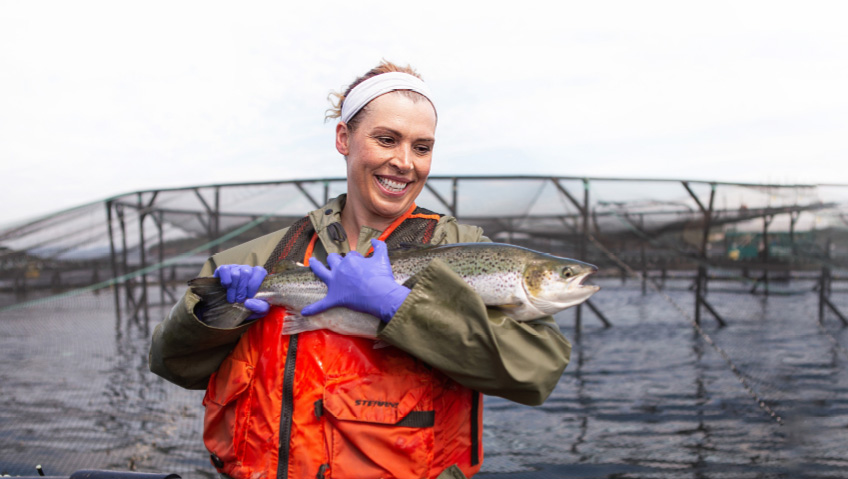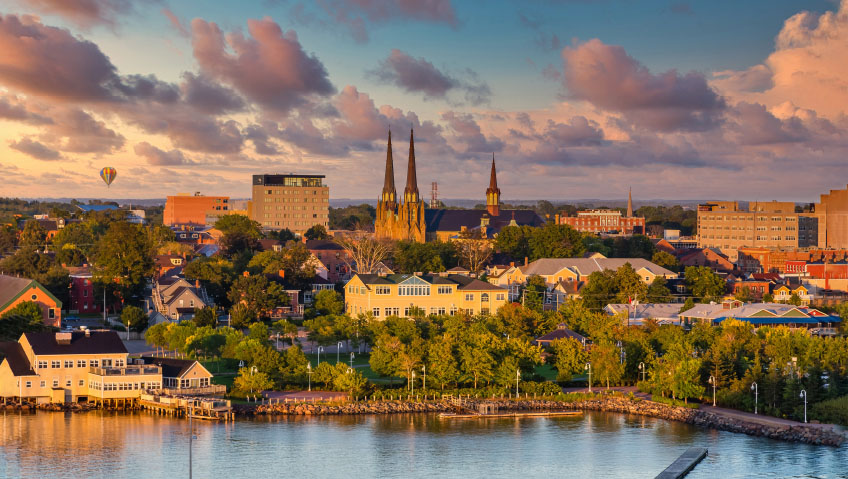The Atlantic Canada Fish Farmers Association (ACFFA) has been keeping busy with advocacy, public education, and conferences, among other activities, since Resource in Focus last profiled the organization in May of 2022. The ACFFA, which represents Atlantic Canada’s salmon farming sector, has also been enjoying the transition “back to a normal work environment,” now that the worst of COVID is hopefully over, says Executive Director Susan Farquharson.
Salmon farming is a type of aquaculture that involves raising fish in underwater pens as opposed to trawling them in the wild. It’s a very big business: on the East Coast of Canada, the sector generates $2 billion in economic output and $800 million in GDP (Gross Domestic Product) annually, while employing over 8,000 people. Atlantic Canadian salmon farmers produce about 350 million nutritious meals each year.
Headquartered in Letang, New Brunswick, the ACFFA has 81 members. Besides fish farmers, members include service providers, research groups, and feed companies. The ACFFA continues to operate the Letang-based Limekiln Wharf Service Centre on behalf of the aquaculture industry.
A return to form
As part of the transition to normality, the ACFFA hosted its annual Research, Science, and Technology forum in St. Andrews, New Brunswick, from October 25th to 27th, 2022.
“It was our first time back in person without health restrictions in years”, says Farquharson. The Association opted to retain a hybrid format, offering presentations, seminars, and speakers in-person and online. That way, people who couldn’t travel to the event were still able to take part.
The forum proved to be a big hit, with approximately 150 registrants, two days of events and presentations, and an inaugural Women of Salmon Farming Symposium. The latter event focused on issues relating to women in the industry, with a view toward promoting gender equity and opportunity. Symposium guests included Marie Terese Letorney, a European opera singer turned communications specialist. Letorney ran a well-received session “on how men and women communicate differently in the business world,” says Farquharson.
In a similar fashion, the Association is putting the finishing touches on a report titled, Gender-Based Opportunities and Challenges in Salmonoid Farming in Atlantic Canada. “We had some details from the draft [report] going into the Symposium, but now, with the results from the Symposium and new statistics from Statistics Canada, we want to incorporate all of those into the final report,” explains Farquharson.
The report will show that women in aquaculture tend to be higher educated than their male counterparts, even though educational achievement has little impact on gender pay ratios, she continues. The Association will host a Women in Seafood roundtable at an upcoming Responsible Seafood Summit “to continue the conversation,” she says.
An international event, the Responsible Seafood Summit used to be called GOAL (Global Outlook for Aquaculture Leadership). Co-hosted by the ACFFA, the rebranded summit will take place this fall in Saint John, New Brunswick. This will mark the first time the event has been held in Canada, with British Columbia hosting the summit a few years ago.
“We’ve put a big effort into bringing that conference here,” Farquharson says. “[It will feature] the thought leaders, the CEOs, the executives of seafood companies… government officials, NGOs; they will all gather. We are working closely with the Global Seafood Alliance to co-host.”
Farquharson also attended the North Atlantic Salmon Conservation Organization (NASCO) conference in Edinburgh, Scotland from June 6th to 9th, 2022. An annual international event, the conference rotates between countries that have wild salmon (a list that includes Canada, Denmark, the European Union, Norway, Russia, the United Kingdom, and the United States). Farquharson typically participates in the conference each year as part of the Canadian delegation.
Advocacy, always
The Inner Bay of Fundy Salmon Recovery Project (iBoF) continues to be one of the ACFFA’s flagship programs. This project aims to replenish stocks of wild salmon, and to achieve this goal, wild smolts (salmon that haven’t reached full maturity and can live in saltwater) are raised in custom-built pens, and then released into Bay of Fundy rivers. This huge undertaking involves a partnership between the ACFFA, Fisheries and Oceans Canada (DFO), Parks Canada, the salmon industry, First Nations groups, and provincial authorities.
Last year, there were “158 returns”—that is, salmon returning to rivers in the inner Bay of Fundy—and things look equally promising this year, says Farquharson.
Advocacy also remains central to the ACFFA’s mission. “I’m always advocating for effective regulatory policies… that’s 90 per cent of my job, communicating for effective regulatory policies and processes in Atlantic Canada. We were really pleased when New Brunswick released its Finfish Aquaculture Development Strategy… Salmon farming started here 40 years ago, so it’s really encouraging to see New Brunswick step up to the plate and want to be leading again in the development of the industry,” states Farquharson.
Finfish include salmon, which is why the report is so significant for the ACFFA. The recently released New Brunswick Finfish Aquaculture Growth Strategy 2022 – 2030 document touches on seven “strategy themes” (land-based aquaculture, governance, competitiveness and science support, fish health, promotion and advocacy, strategic infrastructure, and regulatory efficacy). Presented by the New Brunswick Department of Agriculture, Aquaculture, and Fisheries, the Strategy aims to grow the province’s finfish sector.
As part of its ongoing mission, the ACFFA also works to raise awareness about the importance and realities of Atlantic Canadian salmon farming. “There are still people out there who think we stand on the side of a net pen and throw fish feed in the water with our hands. It’s ridiculous,” states Farquharson.
People are often unaware of how high-tech the field is, employing the latest sensors, computers, automated feeding systems, cameras, monitors, and more. Every aspect of salmon development in aquaculture pens is closely monitored and farmers adhere to strict environmental regulations.
For all that, certain myths continue to prevail, including the notion that aquaculture is bad for the environment and that farmed fish is less nutritious than wild fish.
As the ACFFA points out, aquaculture helps blunt the impact of climate change. According to a 2018 study by the High Level Panel for a Sustainable Ocean Economy (HLP), salmon farming releases fewer greenhouse gas emissions (GHG) than terrestrial animal farming (i.e., raising cows, pigs, and sheep on land)—which is a good thing, given that climate change might have a hugely negative impact on oceans and aquatic life.
“I think anybody that says climate change isn’t affecting them is not looking out their window or paying attention,” states Farquharson.
As for nutrition, Farquharson points to a 2020 research paper in the Journal of Agriculture and Food Research, by Dr. Stefanie Colombo (assistant professor of Aquaculture at Dalhousie University, Nova Scotia). Colombo found there was little difference in the nutritional value of wild salmon and farmed salmon. When it came to health, the key factor was the species involved (Colombo’s study looked at six types of salmon, examining each for levels of fat, protein, amino acids, mercury, fatty acids, and cholesterol), not whether the salmon was farmed or wild.
To enhance its public education efforts, the ACFFA developed a 360° virtual reality Atlantic Canadian salmon farming tour. People can don VR goggles and take a virtual tour, starting at a wharf and leading to a salmon farm, hatchery, and fish lab.
In a similar fashion, the ACFFA launched a “Uniquely Atlantic” digital campaign last spring to highlight the merits of Atlantic Canada farmed salmon. As part of the campaign, the Association refreshed its website and created Instagram reels (short videos that are a hugely popular feature on this social media platform).
“This year, we’re going into TikTok,” notes Farquharson, citing another online platform for user-contributed videos that is much used by young people.
Growing the industry
In addition to raising awareness about the salmon farming sector, the ACFFA hopes such efforts encourage more young people to consider taking aquaculture jobs. Like many industries, Atlantic Canadian salmon farming is suffering from a labour crunch. Many older workers have either retired or are reaching retirement age, and not enough young people are stepping in to fill their positions.
To this end, the ACFFA recently hired a community outreach and education coordinator, whose job involves talking to students and developing packages for guidance counsellors about the industry, says Farquharson. Farquharson herself makes presentations in schools, pointing out how the aquaculture sector is rapidly expanding and in need of new workers.
The ACFFA’s messaging seems to be having an effect. Each year, the Association hires a third-party polling firm to determine what Atlantic Canadians think about salmon farming. In the most recent poll, aquaculture garnered an 81 per cent approval rating (up slightly from the usual 80 per cent result).
Asked to provide a five-year industry forecast, Farquharson envisions more post-smolt facilities, larger hatcheries on land, and a growing awareness of the economic, nutritional, and environmental benefits of Atlantic salmon farming.






